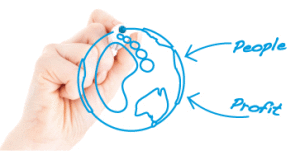Business sustainability is a goal for most enterprises. As a micro business owner you may want to sustain an income to retirement or to hand over a viable business to your family. You might be involved in a larger company which has a responsibility to protect the investment from shareholders and aims to increase its value.
But what is sustainability and how can manufacturers achieve it?
Traditionally businesses maintain a strong focus on factors that have a clear and direct effect on their economic performance. This is usually assessed by looking at financial measures such as cost of materials and overheads, quantity of sales and profit margins.
Increasingly firms are taking a broader view and taking account of their relationship to the environment and the community.
This is not just for the ‘feel good’ factor. It enables them to fully assess the potential and actual impact to their business – the costs and the benefits – from their interactions with the local and broader community and with the physical environment.
You might be making the perfect product with great profit margin. But it is pointless if no one will buy from you because you have a supplier who is known for exploiting underpaid workers or using child labour. Or if the community prevents your trucks picking up or delivering and you can’t get your product to market.
The cost of an environmental accident can go beyond clean up and downtime costs into rehabilitation, legal costs, compensation, customer backlash and negative marketing campaigns.
A broad future focus is essential for the long term viability of a business and ‘sustainability’.
 ‘People – planet – profit’ … the triple bottom line
‘People – planet – profit’ … the triple bottom line
Sustainability usually makes us think about carbon footprints, greenhouse gases and ecosystems. This is the environmental aspect of sustainability.
Two additional aspects are generally recognised as contributing to sustainability: economic factors and social factors.
Together these three pillars of sustainability are often referred to as ‘people – planet – profit’.
Sustainability is a balancing act where business decisions take into account the impact they may have on the three aspects of sustainability including the economic viability of the business.
Social sustainability activities focus on maintaining mutually beneficial relationships with employees, customers and the community.
These activities often have benefits in terms of positive profile and customer and community support.
Environmental sustainability activities focus on the impact of resource usage, hazardous substances, waste and emissions on the physical environment.
These activities may have a direct benefit for a business by reducing costs.
Economic sustainability activities focus on business efficiency, productivity and profit.

